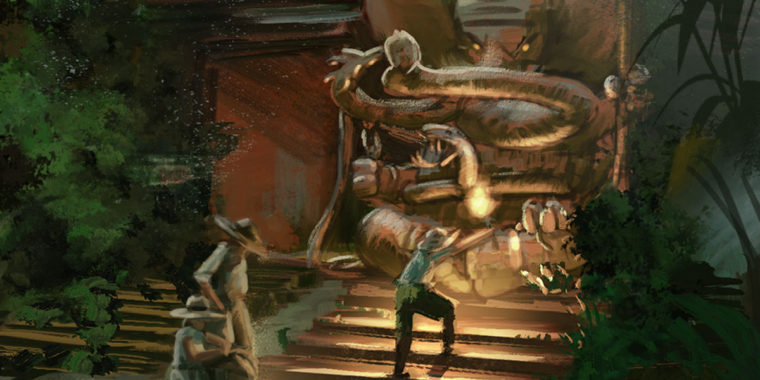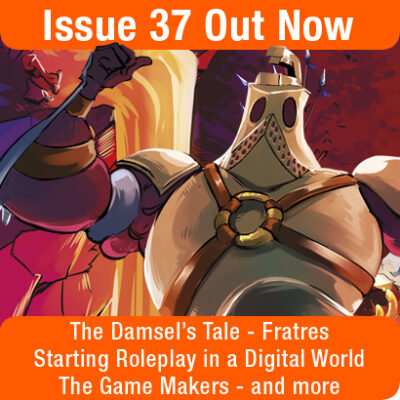Lovecraftian horror isn’t just confined to just misty seaside towns and spooky rural areas. There is a whole world out there, waiting to feel the icy grip of extra-dimensional alien gods.
Sons of the Singularity first introduced players to a new way to look at the Cthulhu Mythos in The Sassoon Files. And now they are back with another journey into the unknown with Journal d’Indochine.
I caught up with Jesse Covner (JC) from Sons of the Singularity to find out what is going down in Vietnam, bringing more horrors to players, and avoiding overzealous foreign censors.

ML: Can you briefly explain what Journal d’Indochine is?
JC: Journal d’Indochine is a set of scenarios and campaign resources for the Call of Cthulhu 7th Edition roleplaying game set in French colonial Vietnam (~1925 to 1955); a land in turmoil as Vietnamese partisans resist French colonial oppressors and Japanese invaders.
ML: Why did you decide to explore French colonial Vietnam as a setting? What about it makes it an interesting addition to the usual horror and Cthulhu Mythos settings?
JC: The adage goes “write what you know”. The corollary for RPG indie publishers is that we should also only publish what we play. We’ve lived in Asia for many years, and our circle of friends are all roleplayers. Journal d’Indochine is the campaign we are currently playing.
As roleplayers, we are also consumers of RPG content and source books already published. Many years ago, we kicked off our first Delta Green campaign with Max Bantleman’s Charlie Don’t Surf, and I can say without any reservations there is already some amazing material out there. If you haven’t already, do yourself a favour and check out Arc Dream’s Delta Green, as well as Pelgrane Press and Ken Hite’s The Fall of Delta Green. These prior works do an exceptional job covering the Vietnam War (or the Resistance War Against America as it is called in Vietnam), but there is very little RPG content on the time before America got entangled. We want to avoid being duplicative of prior efforts, and we want to add to the overall mosaic of Lovecraftian horror set in Asia and ripped from the pages of history.
In our Asian horror line – The Sassoon Files, Journal d’Indochine, and an upcoming project set in post-war Japan – we see ourselves doing what Studio A24 does in their horror films. We are presenting historical and morally ambiguous stories about imperialism, racism, corruption and rebellion. The setting of these stories is not widely known, but is incredibly fascinating. Our team takes this setting and injects unique Mythos story arcs.
ML: What steps have you taken to ensure that the content accurately reflects the time period, and more importantly, the people and cultures of the chosen location?
JC: This is an incredibly important question and it goes to the heart of what we at SOS hope to achieve in publishing RPGs set in Asia. For too long, many Western publishers have perpetuated cultural and race-based clichés and the myth of exotic Asia.
Asian people are not “exotic”. OK, maybe Asian cultures tend to have different values towards family than Westerners, and maybe people in Asia tend to eat more rice as a staple, but they don’t eat strange things any more so than Westerners eat strange things, and in the 20th century, Asians wore clothes designed in the 20th century, if they could afford it. Point is, we will not be fetishising cultural trappings (chopsticks and Asian conical hats) in Journal d’Indochine, just as we did not in The Sassoon Files. We are not going to create NPCs with an exaggerated sense of face or honour. There will not be a martial arts master who dispenses ancient Asian wisdom that sounds like it could have come from a fortune cookie. There is no need to trade on clichés and fetishised trappings; Asian cultures stand on their own and this setting is chock-full of real chaos, intrigue and terror.
One of our writer’s grandfather was at the Battle of Dien Bien Phu, and our project includes photos from his family’s personal archive. His family has history there, and the scenarios he is writing draw from that experience. We have engaged Vietnamese consultants to provide insight and to vet our characterisations of all things Vietnamese. We work with an outstanding Vietnamese artist, Thuận Nguyễn, who recently completed a Viet Minh recruitment poster calling for all people to unite in the fight against Cthulhu.
We do have a keen interest in ensuring that we accurately reflect on the time period, people and cultures of French colonial Indochina. In addition to the research that should go into any RPG resource with a historical setting, we organised a diverse team and then we asked them to draw on what they know.

ML: How does Journal d’Indochine relate to your last resource book The Sassoon Files?
JC: Loosely. Many of the themes are the same. Fictional histories remain consistent; Mythos threats and events occurring in The Sassoon Files exist in Journal d’Indochine. Some of the same characters and factions make an appearance, including for example Inspector Mazenq of the French Settlement in Shanghai. Gen’yōsha, the Japanese ultra-nationalist cult, continues to be a threat. We also hope that some of our Sassoon backers will be interested in transplanting older versions of their pre-gen characters.
ML: You ran into an issue with The Sassoon Files where the Chinese Government destroyed the first print run. What have you put in place to make sure this doesn’t happen again with Journal d’Indochine?
JC: We are printing in the US of A.
ML: What do you think the main drawcard of the book will be? And what about Journal d’Indochine are you most excited for players to discover?
JC: The main draw is going to be Mythos horror done well. Journal d’Indochine is full of rich historical events and fascinating factions, including for example Binh Xuyen gangsters, Vichy French, OSS operatives, and Mythos cultists. Its scenarios are designed to be played “out of the box”. There will also be a huge number of hooks and narrative frameworks for a GM to extend the gameplay. Additionally, Journal d’Indochine will include alternative player factions allowing the campaign can be replayed from the perspective of different factions.
In The Sassoon Files, we used Lore Sheets to convey settings elements. These are hand-outs that have character background information and world-setting information. But in The Sassoon Files, this was placed at the end of the book. We used Lore Sheets in two other projects – Rational Magic and The Camlann Chronicles. This time, we are going to fully integrate Lore Sheets through the main book. We hope this creates a new and exciting way to play the game.
The art pieces we’ve already commissioned are absolutely beautiful, and through the Kickstarter we hope to unlock stretch goals that will allow us to commission more art. The photos, maps and other visual collateral we’ve already gathered enhance both game play and the overall look and feel of the book. Journal d’Indochine will be gorgeous.
Journal d’Indochine is now live on Kickstarter. You can find more about Journal d’Indochine and The Sassoon Files on the Sons of the Singularity website.




